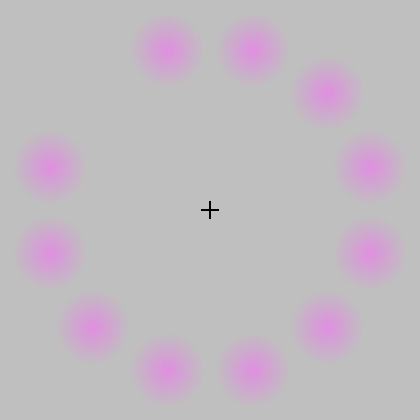Persistence of vision
From Wikipedia, the free encyclopedia
| This article needs additional citations for verification. Please help improve this article by adding reliable references (ideally, using inline citations). Unsourced material may be challenged and removed. (October 2007) |

Persistence of vision is the phenomenon of the eye by which even nanoseconds of exposure to an image result in milliseconds of reaction (sight) from the retina to the optic nerves. This is because persistence of vision depends on chemical transmission of nerve responses, and this biochemical hysteresis is much slower than the light transmission.
The myth of persistence of vision refers to the mistaken belief that human perception of motion (brain centered) is the result of persistence of vision (eye centered). The myth was debunked in 1912 by Wertheimer[1] but persists in many citations in modern texts.[citation needed] Motion perception has been shown to be the result of the Beta Phenomenon.
A visual form of memory known as iconic memory has been described as the cause of this phenomenon[2]. Although psychologists and physiologists have rejected the relevance of this theory to film viewership, film academics and theorists generally have not. Some scientists nowadays consider the entire theory a myth.[3]
Persistence of vision should be compared with the related phenomena of beta movement and phi movement. A critical part of understanding these visual perception phenomena is that the eye is not a camera: there is no "frame rate" or "scan rate" in the eye; instead, the eye/brain system has a combination of motion detectors, detail detectors and pattern detectors, of which each output is combined to create the visual experience.
Persistence of vision was discovered by the Roman poet Lucretius[citation needed].
Contents |
[edit] Film systems
Through experience in the early days of film innovation, it was determined that a frame rate of less than 16 frames per second (frame/s) caused the mind to see flashing images. Audiences still interpret motion at rates as low as ten frames per second or slower (as in a flipbook), but the flicker caused by the shutter of a film projector is distracting below the 16-frame threshold.
Modern theatrical film runs at 24 frames a second. This is the case for both physical film and digital cinema systems.
It is important to distinguish between the frame rate and the flicker rate, which are not necessarily the same. In physical film systems, it is necessary to pull down the film frame, and this pulling-down needs to be obscured by a shutter to avoid the appearance of blurring; therefore, there needs to be at least one flicker per frame in film. To reduce the appearance of flicker, virtually all modern projector shutters are designed to add additional flicker periods, typically doubling the flicker rate to 48 Hz (single-bladed shutters make two rotations per frame - double-bladed shutters make one rotation per frame), which is less visible. (Some three-bladed projector shutters even triple it to 72 Hz.)
In digital film systems, the scan rate may be decoupled from the image update rate. In some systems, such as the Digital Light Processing (DLP) system, there is no flying spot or raster scan at all, so there is no flicker other than that generated by the temporal aliasing of the film image capture.
The new film system MaxiVision 48 films at 48 frames per second, which, according to film critic Roger Ebert, offers even a strobeless tracking shot past picket fences. The lack of strobe (as opposed to flicker) is due to the higher sampling rate of the camera relative to the speed of movement of the image across the film plane. This ultra-smooth imaging is called High motion. It is critical for sports and motion simulation, but unpopular for drama.
[edit] Video systems
Video records at 50 (Eurasia) or 60[4] (US & Japan) images per second (ips) depending on the national system used; The flicker or refresh rate on a television screen is fixed to one or the other nationally chosen standards. A technique called interlace uses persistence of vision to combine two consecutive images (or fields) to create one frame with higher detail in non-moving areas. Because the fields are exposed and displayed separately, a single TV "frame" can potentially contain motion or even two distinct images.
With ordinary video from video cameras, the flicker rate and the image rate are the same. However, when footage shot on 24 Hz film is shown on 60 Hz TV, each film frame is repeated for 2.5 consecutive fields to produce 60 fields per second. (see 3:2 pulldown) In countries using 50 Hz TV, 24 frame/s film is sped up by 4% to produce 25 frames (50 fields) per second.
Many modern video systems also decouple display from image update, for example, systems using LCD or plasma panels with continuous light output, or intermediate frame buffers that increase the display rate to 100 or 120 fields per second. Such implementations can occur on low-flicker purpose-built CRT TVs, but decoupling can happen inadvertently on any display connected to a HTPC.
[edit] Computer monitors
Aside from a few configurations used in the early 1990s, computer monitors do not use interlacing. They may sometimes be seen to flicker, often in a brightly lit room, and at close viewing distances. The latter effect is due to the greater likelihood that part of the screen will occupy the viewer's peripheral vision, where sensitivity to flickering is greater. Generally, a refresh rate of 85 Hz or above (as found in most modern monitors) is sufficient to minimize flicker at close viewing distances, and all recent computer monitors are capable of at least that rate. Flat-panel Liquid Crystal Display (LCD) monitors do not suffer from flicker even if their refresh rate is 60 Hz or even lower. This is because LCD pixels open to allow a continuous stream of light to pass through until instructed by the video signal to produce a darker color (see also ghosting). CRTs by comparison create a momentary burst of light each time the electron beam strikes a particular point on the CRT. [5]
[edit] Cartoon animation

In drawn animation, moving characters are often shot "on twos", that is to say, one drawing is shown for every two frames of film (which usually runs at 24 frames per second), meaning there are only 12 drawings per second. Even though the image update rate is low, the fluidity is satisfactory for most subjects. However, when a character is required to perform a quick movement, it is usually necessary to revert to animating "on ones", as "twos" are too slow to convey the motion adequately. A blend of the two techniques keeps the eye fooled without unnecessary production cost.
Animation for most "Saturday morning cartoons" is produced as cheaply as possible, and is most often shot on "threes", or even "fours", i.e. three or four frames per drawing. This translates to only 8 or 6 drawings per second, respectively.
[edit] Printed media
Flip books use this principle. If the book is flipped at a fast enough speed, the illusion of motion is created.
[edit] Optical toys
[edit] See also
- Light writing, a physical animation technique which has the appearance of persistence of vision, but is wholly different.
[edit] Notes and references
- ^ Wertheimer, 1912. Experimentelle Studien über das Sehen von Bewegung. Zeitschrift für Psychologie 61, pp. 161–265
- ^ Coltheart M. "The persistences of vision." Philos Trans R Soc Lond B Biol Sci. 1980 Jul 8;290(1038):57-69. PMID 6106242.
- ^ Anderson, Joseph; Anderson, Barbara (1993). "The Myth of Persistence of Vision Revisited". Journal of Film and Video 45 (1): 3–12. http://www.uca.edu/org/ccsmi/ccsmi/classicwork/Myth%20Revisited.htm.
- ^ Actually 60 images per 1001ms, commonly rounded to 59.94 or 60 for discussion.
- ^ Contemporary LCD Monitor Parameters: Objective and Subjective Analysis (page 3)
[edit] External links
- Persistence of Vision
- The Myth of Persistence of Vision Revisited - commentary on whether the concept is really a myth.
- The Flicker Fusion Factor Why we can't drive safely at high speed
- Burns, Paul The History of the Discovery of Cinematography An Illustrated Chronology
- Build a SpokePOV: LED Bike Wheel Images

